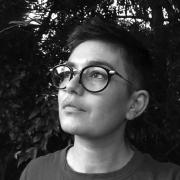Thoughts on Snapcat’s The Beautiful Game
On Saturday 7th April 2018, at the invitation of initiative people+artist+place, Snapcat brought art, in the form of ball sports, to the Brisbane public. Snapcat is the name for collaborative duo Renae Coles and Anna Dunnill, who hail from Perth and are now based in Sydney and Melbourne respectively. Snapcat utilises humour to discuss the political and their offerings are most often found in the public sphere. The event invitation for their most recent work, The Beautiful Game (2018) ended with, ‘…register and armour up or barrack from the sidelines.’ Barracking sounded like something I could manage on what was a glorious Brisbane autumn day, so off I set to the other side of the river. Crossing the river placed my spectatorship on the side of the Southside Tuffs, named after a colour rock formation in Brisbane suburb Kangaroo Point and in opposition to the rival team Northside Lamingtons, named after Lady Lamington (yes, the said inventor of the mighty lamington) and her position at Old Government House.
I arrived at the ‘field’ (a sectioned off area in the expansive New Farm Park) to a scene that looked like it might have been inspired by Willy Wonka's Chocolate Factory: brightly coloured team costumes and bunting, a giant red lamington sculpture, snacks, and a handmade six-foot ball. People were getting dressed in the provided kit (hand-made brightly coloured headbands and vests) in the colours of their team, and meeting their teammates for what was most likely the first time, or grabbing a flag or a set of pom-poms and finding a good position on the sidelines. The air was primed with excitement and comradery. I quickly took my seat on the sidelines, all the players ran on to the field, and the whistle blew. There was a quick surge of movement on the ground, and then in what seemed to be slow-motion, people across a range of ages pushed and struggled over the oversized ball.
As the minutes passed, the view from the sideline did not appear to change. I was reasonably sure that the aim of the game was to get the ball to one end in any way possible to score a goal and yet, the ball seemed to be going nowhere. The players could not outwit nor out-strength each other, try as they might. For approximately the first five minutes in my role as spectator, I was intrigued and slightly confused. On their website, Snapcat describe The Beautiful Game as a work ‘dissecting and splicing the cultures of football and feminism’. [1] As someone who is not a fan of spectator sports, watching sport, even when framed as art, felt odd to me. While I am a recent team-sport playing convert (it is my new favourite form of meditation), I don’t think I’ll ever come to a place where gathering around to watch people fight over a ball will make sense to me, particularly with the aggression that so often fills the airspace of both the players and the spectators (why a team’s win or loss on the field and on the television screen impacts people’s day-to-day lives just seems so peculiar). On the field in front of me, there seemed to be the general team-sport affiliated rivalry and cheering in opposition, although it was marked with a light-heartedness that I would associate with my weekly social game rather than the professional arena. With all the usual team-sport ingredients, I couldn’t help but think, ‘what’s Feminism got to do with this?’
It was after approximately five minutes of watching this futile dance that it dawned on me: the ball was literally going nowhere. It moved around, up a little, over a little, down a little—there seemed no end in sight and certainly not a winner. In fact, the two teams appeared to have become one as they writhed around the ball; it was mesmerising. I was hooked and wanted more of this frivolousness! Time passed quickly in this no-go zone, the half-time whistle blew, and it was time for the players to get together to talk strategy. During the halftime break, the team captains held a meeting, and the rules were changed. The whistle blew again, and this time only three players from each team made their way on to the field. Suddenly, the ball was moving, slowly but surely, and right before the full-time whistle, a team was victorious. While there was much cheering from the sidelines and on the field, I could not help but feel disappointed. I had welcomed what I had thought was a performance highlighting the absurdity of the game and the aggressive characteristics that come with it. In the framing document sent to the producers of the event, Snapcat proposed that The Beautiful Game presents a parody of ‘hyper-masculinity’, against ‘the gendered nature of aggression’. [2] Extending the invitation to women and non-binary persons only within this framework suggests that masculinity and aggression are solely male-based phenomenon. I can’t help wonder what the work might have said about the futility of it all if it included all people regardless of their gender identity in the ridiculous activity at play.
The Beautiful Game provided an always-welcome opportunity to engage with art, politics and community via team-sports sans aggression. The waving of pom poms, cheering from the sidelines for all players, and the overall feeling of generosity, particularly emanating from the artists, provided a space that prompted a range of results, from a fun day out to critical reflection on the role of ball sports and their potential to act as a springboard for unpacking the role of feminism today. I’m looking forward to the opportunity to engage in future Snapcat events, and will hopefully be brave enough to participate more fully next time.
[1] Snapcat, ‘The Beautiful Game’, http://www.snapcatsnapcat.com/the-beautiful-game/; accessed 1 August 2018.
[2] Snapcat, Concept Statement, 2018 (unpublished).











